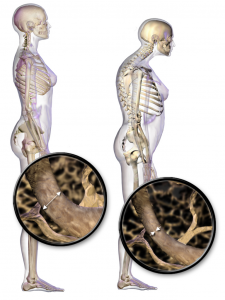No one likes to feel pain, especially when it can prevent you from living a happy and healthy life. Being unable to carry out activities that once brought you joy, such as exercising, or even simple daily tasks, can be very difficult to handle. Diseases like osteoporosis can cause exactly this type of problem. But how do you know it’s osteoporosis? What are the causes of this disease? And the symptoms? How is osteoporosis treated? If you want to know more about the disease, keep reading to get all the information you need.
What is Osteoporosis?
Osteoporosis is a disease characterized by the deterioration of bone structure and a decrease in bone mass. In other words, it is the wearing down of a person’s bones, which can lead to consequences such as a high risk of fractures. Osteoporosis causes a person’s bones to absorb less calcium and minerals, making the bones increasingly fragile. For this reason, it is important for treatment to begin quickly so the person does not suffer even more from the effects of the disease. Someone with osteoporosis must be extra careful with falls and bumps, as their bones are much more fragile and susceptible to breaking. This disease is much more common in women, especially after menopause.
Causes of Osteoporosis
Osteoporosis is a disease that becomes much more common as we age, especially in women over 50, due to menopause as mentioned earlier. However, this is not the only factor that causes the disease. There are also other things that can contribute to both women and men developing it. Some of the main causes of osteoporosis are:
- Alcoholism
- Smoking
- Autoimmune diseases such as lupus or multiple sclerosis
- Calcium deficiency
- Vitamin D deficiency
- Sedentary lifestyle
- Poor diet
As you can see, there are many causes of osteoporosis and they are not always directly related to the risk group, even though any of these factors combined with age definitely increase the risk of developing the disease.
What are the Symptoms of Osteoporosis?
One of the main dangers of osteoporosis is that it rarely presents clear symptoms and is usually only noticed after a fracture. Still, there are some signs to look for, such as:
- Increased bone sensitivity
- Curved posture
- Loss of height over the years
- Bone pain
These symptoms usually get worse over time and, for this reason, treatment should start as soon as possible.
Types of Osteoporosis
Osteoporosis is a disease that can manifest in several different ways and, for this reason, it is divided into types. Some of the main ones are:
- Senile Osteoporosis
- Secondary Osteoporosis
- Pre-Menopausal Osteoporosis
- Osteoporosis in Men
Let’s discuss each one in more detail so you can better understand the differences and how they appear in a person’s body.
Senile Osteoporosis
It occurs due to aging, especially after the age of 70, and can affect both men and women. It usually happens due to the body’s reduced production of Vitamin D, which causes the bones to become more fragile.
Secondary Osteoporosis
This type of osteoporosis occurs because of another underlying issue the person has experienced, such as blood disorders or hormonal problems, for example. While it can affect younger people, it is much more common in older women.
Post-Menopausal Osteoporosis
This is one of the most common types of osteoporosis, caused by a decrease in estrogen, the main female hormone, which in turn reduces absorption of minerals and vitamins essential for bone health.
Osteoporosis in Men
Although it isn’t a specific type of osteoporosis, it is important to discuss how the disease manifests in men, as it is much more common than many people think, especially in older men. Although bone mass loss in men occurs noticeably later than in women, it does happen. Since this disease does not usually present many symptoms, it is often only after a fracture that a man receives the correct diagnosis. Despite this, it is important to take all preventive measures and follow proper treatment to avoid more serious consequences. 
Treatment of Osteoporosis
It is very difficult to say that osteoporosis can be cured, since it is practically impossible. However, treatments are available to prevent the disease from getting worse or to minimize the consequences of possible injuries. All treatment is carried out, basically, with medications to prevent bone mass loss and treat any associated diseases. It is important to emphasize that you should never self-medicate in cases of osteoporosis. Only a medical specialist can determine the best treatment for you and prevent the disease from harming your life.
Consequences of Osteoporosis
When treatment is not done properly, osteoporosis can cause some serious consequences, such as injuries to important bones like the spine, hip, and femur, as these are some of the most affected areas by the disease. This can make it very difficult for a person to walk and, in more severe cases, may even prevent them from walking again. Although it is something you will have to get used to living with, osteoporosis can be treated and controlled, as you have seen. The most important thing is to identify the disease and receive the best possible treatment so that you can live a healthy and normal life as much as possible. This involves eating well, having healthy habits, and taking medications conscientiously and never on your own. That way, living with osteoporosis will not be so difficult. Important tip: A good vitamin complex combined with vitamin D and calcium makes all the difference! So, we recommend FamiPlena. Learn more about it here.











